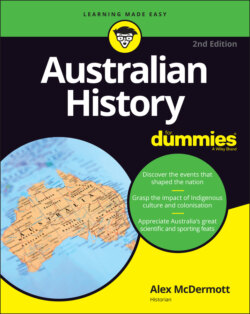Читать книгу Australian History For Dummies - Alex McDermott - Страница 13
Leaping into the big time with wool
ОглавлениеAt first, NSW was a trading and maritime colony. In 1808, 20 years after first settlement (and about the same time Governor Bligh was arrested by an extremely irritated populace — see Chapter 4) the population of the main port town, Sydney, was about half that of the entire colony. In the 1820s and 1830s, a real foothold finally started to be put down on the broader continent because of one main factor — the take-off of wool.
Australia’s south-eastern grasslands, the end product of millennia of firestick farming burn-offs by Aboriginals (performed to attract kangaroos and other game to the new-growth grassland), were discovered to be perfect for grazing sheep on. And sheep grew wool. And wool was just what the new textile industries of Britain’s industrial revolution wanted a lot of. (See Chapter 6 for more on the prosperity brought about by sheep farming and the land grab that followed.)
Not for the last time, Australia’s jump into big-time prosperity had everything to do with high demand for raw materials from a nation flexing its muscles as a newly arrived industrial giant. (America, Japan and China would all play similar roles at different times in the 20th century.) Not for the last time, either, would a massive inward surge of investment capital make for a leveraging up of debt levels that meant when crunch time came, as crunch time tends to do, bankruptcies started popping up like toadstools everywhere (see Chapter 7).
